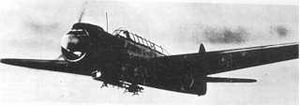Nakajima B6N
| B6N | |
|---|---|

| |
| B6N2 in flight | |
| Role | Torpedo bomber |
| Manufacturer | Nakajima Aircraft Company |
| First flight | 1941 |
| Introduction | 1943 |
| Retired | 1945 |
| Primary user | Imperial Japanese Navy |
| Number built | 1,268 |
The Nakajima B6N Tenzan (Japanese: 中島 B6N 天山—"Heavenly Mountain", Allied reporting name: "Jill") was the Imperial Japanese Navy's standard torpedo bomber for the final years of World War II. It was the successor of the B5N "Kate" and replaced that aircraft in service.
The B6N was a highly effective torpedo bomber. By the time it reached service, however the IJN had a shortage of experienced pilots; furthermore the United States Navy had already achieved air superiority over the Pacific. Thus the B6N never really had the opportunity to display its full potential.
Design and development

The B5N's weaknesses had shown themselves early in the Second Sino-Japanese War and as well as updating that aircraft, the Navy began seeking a replacement. In 1939, it issued a specification to Nakajima for an aircraft that could carry the same weapons load as the B5N but do it faster and over a longer range. The design was restricted by the fact that it also had to fit into the flight deck elevators of existing aircraft carriers—which the B5N already almost filled. This latter restriction resulted in the characteristic shape of the B6N's tail fin with its forward-sloping rudder.
Unlike its predecessor, development was long and fraught with problems, including serious instability shown by the prototypes after flight testing began in early 1941, engine problems, and problems associated with carrier take-offs and landings. Rectifying these issues would mean that two years would pass before the aircraft was finally ready for squadron service. Even then, the aircraft's weight meant that it could only operate from the largest carriers in the fleet.
The B6N1's combat debut was nothing short of disastrous. The Battle of the Philippine Sea had them operating in an environment where the U.S. had such air superiority that they failed to inflict any significant damage whatsoever, whilst taking heavy losses from the U.S. Navy's new F6F Hellcat fighter. Following this debacle, the Navy ordered several changes to the design, most notably replacement of the NK7A Mamoru 11 engine with the Mitsubishi MK4T Kasei 25, resulting in the B6N2.
By this point, small improvements in the B6N's performance were amongst the least of the Japanese Navy's problems. When the new model became available in mid-1944, Japan had already lost most of its large carriers, and was becoming desperately short of experienced pilots. The vast majority of B6N2 operations therefore took place from land bases, and failed to achieve any major successes. The planes were extensively used in the Battle of Okinawa, where they were also used for kamikaze missions for the first time.
With the Navy's priorities now shifting to the impending defense of the home islands, a final version of the aircraft was produced for land-only use, sacrificing its carrier operations features in exchange for a little more performance due to weight savings. Two B6N3 prototypes were completed, but Japan surrendered before this variant could be put into production.
A total of 1,268 B6Ns were completed, almost all of them B6N2s. Today only one remains, preserved at the National Air and Space Museum in Washington, D.C..
Variants


- B6N1 : Prototypes - Engine Nakajima NK7A Mamoru 11 of 1,394 kW (1,870 hp), four-blade propeller. Two examples built.
- B6N1 Tenzan Navy Carrier Based-Attack Bomber, Model 11: First series model. 135 built.
- B6N2 Model 12: Main production model, featured Mitsubishi MK4T Kasei 25 of 1,380 kW (1,850 hp).
- B6N2a Model 12A: Revised tail armament. 7.7 mm (.303 in) Type 97 machine gun, replaced with one 13.2 mm Type 2 machine gun.
- B6N3 Model 13 Prototypes: Engine Mitsubishi MK4T-C Kasei 25c of 1,380 kW (1,850 hp). Modified landing gear for opered in land bases, two B6N2a converted in factory.
- Total Production (all versions): 1,268 examples.
Survivors

One fuselage, minus powerplant and vertical stabilizer, is in storage in the United States.[1]
Operators
Specifications (Nakajima B6N2)
Data from Japanese Aircraft of the Pacific War[2]
General characteristics
- Crew: 3
Performance
- Climb to 5,000 m (16,400 ft): 10 min 24 sec
Armament
- Guns: 1 × 7.7 mm (0.303 in) Type 92 machine gun in engine cowling and 1 × 7.7 mm (0.303 in) Type 92 firing through ventral tunnel
- Bombs: 1 torpedo or 6 × 800 kg (1,760 lb) of bombs
See also
References
Notes
- ^ B6N survivor
- ^ Francillon 1970, p. 433.
Bibliography
- Francillon, René J. Imperial Japanese Navy Bombers of World War Two. Windsor, Berkshire, UK: Hylton Lacy Publishers Ltd., 1969. ISBN 0-85064-022-9.
- Francillon, R. J. Japanese Aircraft of the Pacific War. London: Putnam, 1970. ISBN 0 370 00033 1.
- Francillon, René J. Japanese Aircraft of the Pacific War. London: Putnam & Company Ltd., 1979. ISBN 0-370-30251-6.
- Francillon, René J. Japanese Carrier Air groups 1941-45. London: Osprey Publishing Ltd., 1979. ISBN 0-85045-295-3.
- Thorpe, Donald W. Japanese Naval Air Force Camouflage and Markings World War II. Fallbrook, California; Aero Publishers Inc., 1977. ISBN 0-8168-6587-6. (pbk.) ISBN 0-8168-6583-3. (hc.)
- Wieliczko, Leszek A. and Argyropoulos, Peter. (transl.) Nakajima B6N "Tenzan" (Famous Airplanes 3) (Bi-lingual Polish/English). Lublin, Poland: Kagero, 2003. ISBN 83-89088-36-3.
